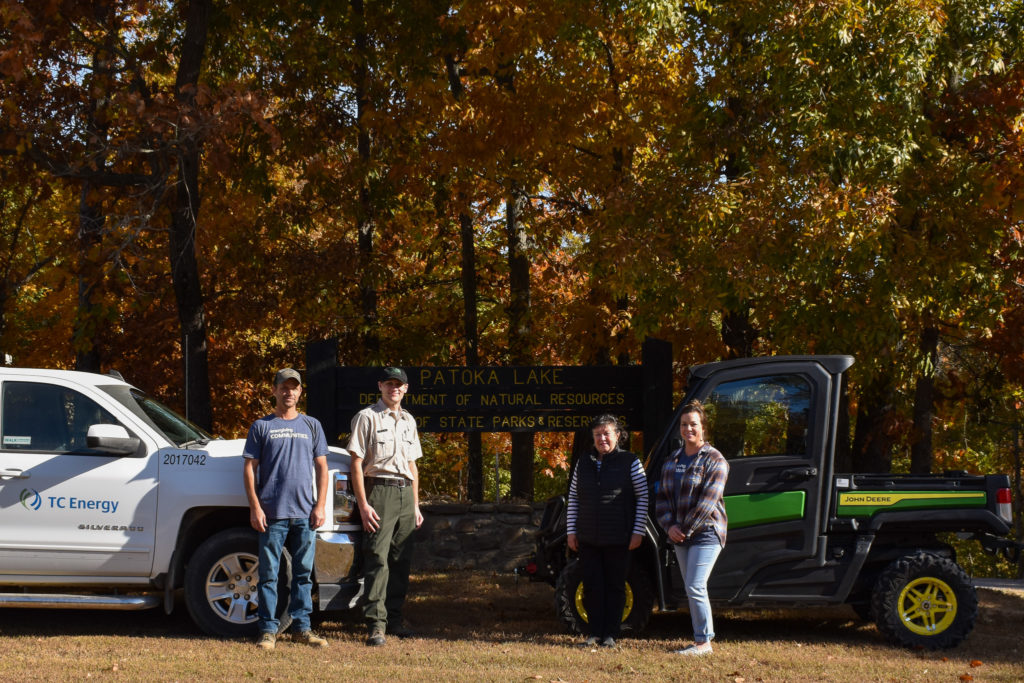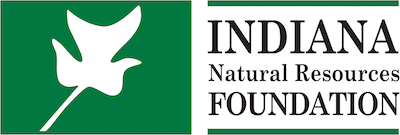TC Energy Foundation Grant Supports Prescribed Fire at Patoka Lake
The TC Energy Foundation recently awarded a $22,000 grant to the Indiana Natural Resources Foundation (INRF) that supported the purchase of a utility terrain vehicle (UTV) at Patoka Lake. The UTV, which will primarily assist with prescribed fire, gives Indiana DNR staff more resources to better manage the diverse habitat around the property.
Prescribed burning often takes place in the spring or fall and is an important habitat management practice. While prescribed fires are commonly used at Patoka Lake and many other DNR properties, the UTV will make the process more efficient.

Pictured Left to Right: Adam Bieker, Celestine compressor station mechanic; Brian Finch, wildlife specialist and assistant property manager; Missi Bush-Sawtelle, INRF board chair; Jenna Cole, Celestine area admin analyst.
“UTVs play an important role in prescribed fires with their mobility and their ability to haul weight and move crew members around the burn site,” said Brian Finch, wildlife specialist and assistant property manager at Patoka Lake.
Outfitted with a water tank and pump, the UTV helps manage the intensity and spread of the fire. The UTV will also carry spare firefighting tools, fuel, water hoses, and additional personnel during prescribed burns.
Historically, fires have been a common and necessary ecological disturbance. Whether started by natural causes such as lightning or by people, fires provided important benefits to forest and grassland habitats. When planned and executed appropriately, prescribed fire mimics the natural disturbances and improves the habitat.

A prescribed fire slowly creeps towards Patoka Lake through an oak-hickory woodland.
The Patoka Lake property is more than 93% forested, with much of it oak-hickory forestland, noted Finch.
“Oak-hickory forests have been documented as declining through the eastern United States,” he added. “This is due in part to a lack of forest management, the absence of once common disturbance-causing insects and large animals (elk, bison, etc.), and decades of fire suppression.”
Oaks, hickories, and grasses and flowers within forests require sunlight to thrive and reproduce. When there is a lack of disturbance, shade-tolerant trees and shrubs begin to take over. This influx of other species also limits important habitat for wildlife. Bird species such as the Northern bobwhite and the Western meadowlark, an Indiana species of concern, rely on the young and diverse habitat that thrives after a controlled burn.

A prescribed fire ignition specialist walks along a gravel road igniting a prescribed fire. This prescribed fire was done to reduce maple and beech in the understory, improving sunlight access to the forest floor to help regenerate oak and hickory trees.
In addition to being an important safety tool during the burns, the UTV allows Patoka Lake staff to better manage invasive species in heavily trafficked areas. Japanese stiltgrass, autumn olive, and multiflora rose are a few of the invasives that staff will be able to better target using the UTV.
The support from the TC Energy Foundation and the work of the Patoka Lake staff will benefit the property and the species that reside there for years to come. The UTV provides a vital tool in the ongoing management of the property’s natural resources.
“TC Energy Foundation supports a sustainable future by investing in organizations that protect ecologically sensitive landscapes, species at risk and restore important wildlife habitats,” said Charles Hearne, TC Energy advisor, community and workforce giving. “We are proud to partake in the Indiana Natural Resources Foundation’s work to protect public lands and endangered species across Indiana.”
We can protect and preserve Indiana’s natural legacy thanks to the generous support of our donors and partners. If you wish to help us maintain Indiana’s rich biodiverse ecosystems, please consider donating to the INRF today.
Prescribed fire photos courtesy of Brian Finch.
